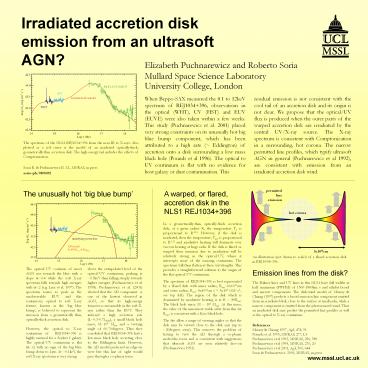Irradiated accretion disk emission from an ultrasoft AGN? PowerPoint PPT Presentation
Title: Irradiated accretion disk emission from an ultrasoft AGN?
1
Irradiated accretion disk emission from an
ultrasoft AGN?
Elizabeth Puchnarewicz and Roberto Soria Mullard
Space Science Laboratory University College,
London
When Beppo-SAX measured the 0.1 to 12keV spectrum
of REJ1034396, observations in the optical
(WHT), UV (HST) and EUV (EUVE) were also taken
within a few weeks. This study (Puchnarewicz et
al. 2001) placed very strong constraints on its
unusually hot big blue bump component, which has
been attributed to a high rate ( Eddington) of
accretion onto a disk surrounding a low mass
black hole (Pounds et al 1996). The optical to UV
continuum is flat with no evidence for host
galaxy or dust contamination. This
residual emission is not consistent with the cool
tail of an accretion disk and its origin is not
clear. We propose that the optical/UV flux is
produced when the outer parts of the warped
accretion disk are irradiated by the central
UV/X-ray source. The X-ray spectrum is consistent
with Comptonization in a surrounding, hot corona.
The narrow permitted line profiles, which typify
ultrasoft AGN in general (Puchnarewicz et al
1992), are consistent with emission from an
irradiated accretion disk wind.
The spectrum of the NLS1 REJ1034396 from the
near-IR to X-rays. Also plotted as a red curve is
the model of an irradiated optically-thick,
geometrically-thin accretion disk. The high
energy tail includes the effects of
Comptonization.
Soria R. Puchnarewicz E. M., MNRAS, in
press astro-ph/0108492
The unusually hot big blue bump
A warped, or flared, accretion disk in the NLS1
REJ1034396
In a geometrically-thin, optically-thick
accretion disk, at a given radius R, the
temperature Tn is proportional to R-3/4. However,
if the disk is irradiated, then the temperature,
Tirr, is proportional to R-1/2 and irradiative
heating will dominate over viscous heating at
large radii. If the disk is flared or warped then
emission due to irradiation will be relatively
strong in the optical/UV, where it intercepts
more of the ionizing continuum. The spectrum will
then flatten at these wavelengths. This provides
a straightforward solution to the origin of the
flat optical/UV continuum. The spectrum of
REJ1034396 is best represented by a flared disk
with inner radius, Rinn6x1011cm and outer
radius, Rout5x1016cm ( 3x105 GM/c2 see top
left). The region of the disk which is dominated
by irradiative heating is at R gt 80Rinn. The
black hole mass, M 106 Msun. At this mass, the
value of the innermost stable orbit from this
fit, Rinn, is consistent with a Kerr black
hole. The fits allow a range of viewing angles so
that the disk may be viewed close to the disk
axis (up to 20degrees away). This removes the
problem of having to view the AD through a
co-planar molecular torus and is consistent with
suggestions that ultrasoft AGN are seen
relatively face-on (Puchnarewicz 1992).
An illustration (not drawn to scale!) of a flared
accretion disk in REJ1034396.
The optical/UV continua of most AGN rise towards
the blue with a slope a0.4 while the soft X-ray
spectrum falls towards high energies with a2
(e.g. Laor et al. 1997). The spectrum seems to
peak in the unobservable EUV and this continuous,
optical to soft X-ray feature, known as the big
blue bump, is believed to represent the emission
from a geometrically thin, optically thick
accretion disk. However, the optical to X-ray
continuum of REJ1034396 is highly unusual for a
Seyfert 1 galaxy. The optical/UV continuum is
flat (a1) with no sign of the big blue bump down
to Lya. At 0.1keV, the soft X-ray spectrum is
very strong
above the extrapolated level of the optical/UV
continuum, peaking at 0.3keV then falling
steeply towards higher energies (Puchnarewicz et
al. 1998). Puchnarewicz et al. (2001) showed that
the AD component is one of the hottest observed
in AGN, so that its high-energy turnover is
measurable in the soft X-rays rather than the
EUV. They inferred a high accretion rate
(L0.3-0.7LEdd), a small black hole mass, M106
Msun and a viewing angle of 60-70degrees. Thus
they concluded that REJ1034396 had a low-mass
black hole accreting close to the Eddington
limit. However, the AD model preferred an edge-on
view but this line of sight would pass through a
co-planar torus.
Emission lines from the disk?
The Balmer lines and UV lines in this NLS1 have
full widths at half maximum (FWHM) of
1500-1800km/s and exhibit broad and narrow
components. The disk-wind model of Murray
Chiang (1997) predicts a broad emission line
component emitted from an irradiated disk, close
to the surface at small radii, while a narrow
component is emitted from the photoionized wind.
Thus an irradiated disk may predict the permitted
line profiles as well as the optical to X-ray
continuum.
OM
References Murray Chiang 1997, ApJ, 474,
91 Pounds et al. 1995, MNRAS, 277,
L5 Puchnarewicz et al 1992, MNRAS, 256,
589 Puchnarewicz et al 1995, MNRAS, 276,
20 Puchnarewicz et al 2001, ApJ, 500, 644 Soria
Puchnarewicz 2001, MNRAS, in press
www.mssl.ucl.ac.uk

